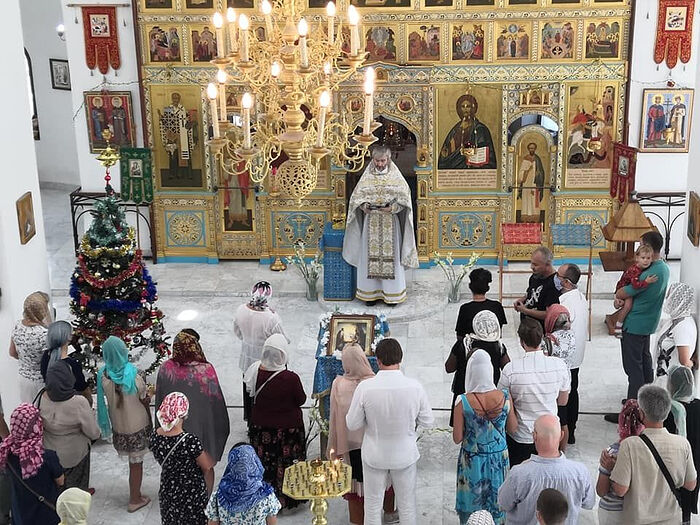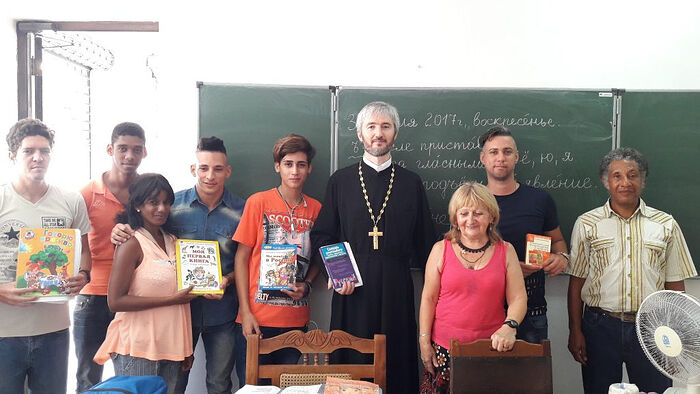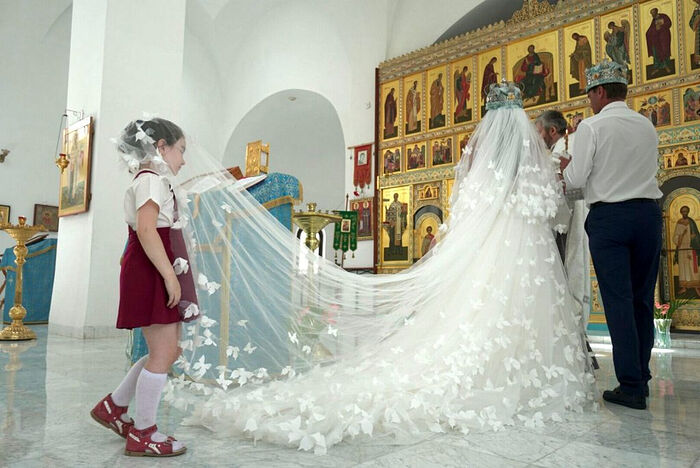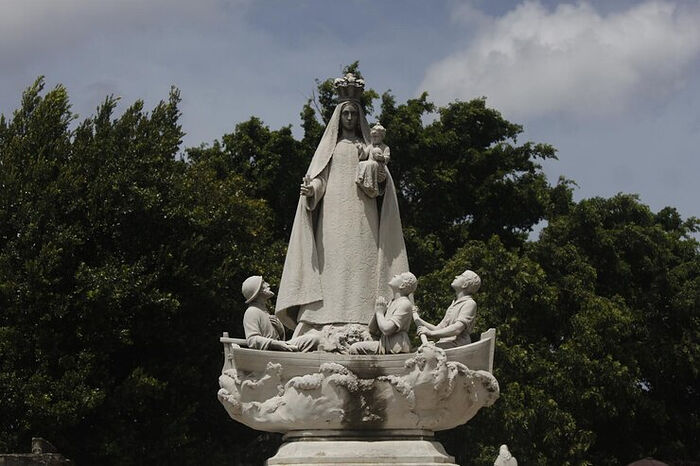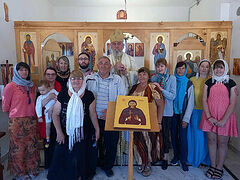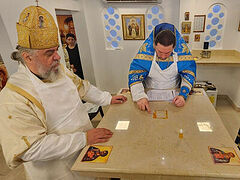—Is the community large today? Does it consist of Russians or are there representatives of other nationalities, including locals?
—The community is small. Some of our parishioners are diplomats who were sent to Cuba and employees of various organizations. At the services you can see Russians, Ukrainians, Belarusians, Serbs, Bulgarians and Romanians. There are also some Cubans who converted to Orthodoxy. The parish is mixed. But, in addition to the community, there is a broad circle of people with whom we maintain friendly relations, and they are our frequent guests. Some of them are non-religious people, others are on their way to the faith, but all of them are united by love for Russian culture. They could be called “associate members” of our community.
—Is there any pattern in the motivations of compatriot parishioners who moved to the country from Russia and other parts of the Russian-speaking world?
—Most of our compatriots are women who in the Soviet era and later married Cubans. Therefore, everything is here for love.
—Can you give us the most striking example of the conversion of one of the locals to Orthodoxy, or just an interesting example?
—I can’t really give striking examples, but there are cases when Cubans have displayed a genuine interest in Orthodoxy. Without knowing the Russian language and culture, they attended all Sunday services, tirelessly listening to singing, prayers and sermons, gradually becoming members of our parish community. I have had occasion to baptize such people or receive them into Orthodoxy. There is a certain mystery here that inspires one with awe and makes you marvel at a person’s conversion to God in spite of cultural, and perhaps, even civilizational obstacles.
We have a reader named Dmitry from Cuba, who is Russian on his mother’s side. Such people are usually called “halves” here, but he considers himself 100 percent Cuban and 100 percent Russian. And indeed he is. The depth of his knowledge of Orthodoxy, Russian culture and language is impressive—it is as if he lived in Moscow or St. Petersburg and not in Cuba. You cannot surprise anyone with knowledge of Pushkin or Dostoevsky, but when the names of the philosophers Lev Shestov, Konstantin Leontiev, Alexander Kozhev, Fr. Pavel Florensky, Alexei Losev, along with contemporary intellectuals widely known only in narrow circles, pop up in a conversation in Cuba, it’s more than impressive. Such people are a living bridge between our countries and cultures.
—What language do you worship in? Are there any peculiarities in the celebration of services? Perhaps some local traditions have developed and there are some special festivals?
—Services in our church are celebrated in two languages: Church Slavonic and Spanish. There are cases, depending on circumstances, when we serve mostly in Church Slavonic, or in Spanish. As a rule I deliver sermons in Russian, but they are accompanied by simultaneous translations into Spanish through the efforts of Dmitry Prieto.
Cubans especially venerate St. Lazarus from the Parable of the Dives [the rich man] and Lazarus (Cuban Catholics consider him as a historical person), along with Great-Martyr Barbara; in Havana they venerate St. Christopher, the patron-saint of the capital. On the anniversary of the foundation of Havana, November 16, a procession with a sculpture of him marches through the streets of Old Havana.
—Are your parishioners involved in the life of the community?
—The central event of parish life is the Eucharist. The Liturgy is the main uniting factor. After services our parishioners do not part, but stay for tea or coffee, and at these meetings we often read and discuss various texts of a spiritual and cultural nature together. Our parishioners certainly contribute to the upkeep of the church, but on the whole, we are supported by the Moscow Patriarchate. As such, in the legal sense, we have no parish council and no parish assembly.
—Do you do any educational, charitable or social projects?
—Before the pandemic, we held Russian and Spanish language courses and Bible courses at the church. All of this should resume. Together with the Federal Agency for the Commonwealth of Independent States, Compatriots Living Abroad, and International Humanitarian Cooperation (Rossotrudnichestvo), various events are held at the church. For example, the Day of Family, Love and Fidelity, the “Candle of Memory” memorial action (a tribute to the memory of millions who died during the Great Patriotic War1), children’s Christmas parties and even International Women’s Day on March 8, because the bulk of the diaspora are women with a Soviet past.
Along with consular officials I sometimes visit Russian prisoners in Cuba. We try to help them both spiritually and financially. Social service comes down to mutual support within the parish community, but sometimes we also collect aid for victims of various cataclysms—usually hurricanes.
—Tell us about the brightest events in the life of the parish over recent years.
—The most striking and resonant event was the celebration of the tenth anniversary of the consecration of the church. The festal service was headed by Metropolitan Anthony of Volokolamsk, the current Chairman of the Moscow Patriarchate’s Department for External Church Relations. During his stay in Cuba a number of meetings took place—with the Nuncio of the Vatican in Cuba, with the Roman Catholic Archbishop of Havana, with the chief historian of Havana, Eusebio Leal of blessed memory, who was responsible for the preservation of the historical heritage of Old Havana and played a significant role in the opening of our church. A reception was given by the church on the occasion of the anniversary.
By the anniversary we had managed to carry out large-scale work: painting the facades of the church, the bell-tower and the parish house, polishing the marble floors in the church, and repairing the air conditioning system in it. For the anniversary, a children’s prayer-book was also prepared in Spanish with original illustrations by a local artist with Russian roots on his maternal side, Ernesto Litvinov.
Among recent notable events I can mention the donation to our church of an icon of Holy Righteous Fyodor Ushakov with a particle of his uniform on November 17 of this year. The icon was presented by Sergey Cheryomin, Minister of the Moscow City Government, Head of the Moscow City Department for External Economic and International Relations, who visited Cuba as part of the Days of Moscow in Havana program. This is a gift from Archimandrite Innocent (Rudenko), Abbot of the Sanaxar Monastery of the Nativity of the Mother of God [in the Republic of Mordovia in Russia.—Trans.], to our church, for which we are very grateful to him.
—Do you maintain ties with your homeland at the parish level?
—Our remoteness from our homeland affects and complicates interaction. But there are exceptions. For example, the above-mentioned publication of a prayer-book in Spanish became possible thanks to the support of Archpriest Oleg Kostroma, Chairman of the Information Department of the Gomel Diocese of the Belarusian Orthodox Church.
—Do you manage (if it’s necessary) to interact with representatives of non-Orthodox Christians and other faiths?
—Historically, Cuba has been a Catholic country. Various Protestant communities are also strong here. Afro-Cuban religious cults are rapidly developing. The authorities are interested in preserving interfaith peace and harmony. Our parish mainly interacts with the Catholic Church and various Catholic organizations—for example, with the Community of Sant’Egidio, a lay Catholic association dedicated to social service, and with the Focolare movement. Before the construction of the Church of the Kazan Icon, the Catholic Church had kindly provided its churches in Havana for Orthodox services. It is still the case today when it comes to holding services outside Havana.
—How are relations with the State developing?
—Our relations with the authorities are built on mutual respect. A special department in the Central Committee of the Communist Party of Cuba for interaction with religious organizations oversees the activities of the latter. We have very good relations with the Head of the Department. There are no obstacles to our activities on the part of the authorities: on the contrary, they are always ready to provide support and assistance.
—Do you have a secular job? Do you think a priest should have one?
—I spend all my time serving at the church and solving issues related to the parish life. I am fine with the idea of combining ministry and work. It all depends on the circumstances and the type of activity. Of course, there are some types of work that are incompatible with the priestly ministry. In the Western world a working Orthodox priest is common.
—What serious spiritual questions from the parishioners do you as a pastor encounter in your ministry?
—As part of his ministry, a pastor is called to provide spiritual guidance to the faithful. To pastor means to guide on the right path, avoiding dangers. People often turn to a priest when they find themselves in a difficult situation, hoping to receive practical advice and guidance. The fate of a person may depend on a priest’s advice—for example, whether a family will be preserved or break up. There are such complex conflicts that often my life and modest spiritual experience are not enough. Then a way out must be sought in simple human sympathy and, of course, in prayer. After all, our main Helmsman is Christ.
—What do you regard as the challenge of the times for an Orthodox person? Perhaps specifically in Cuba.
—Throughout all times it has been important to find a balance between the eternal and the temporal, the spirit and the letter, the content and the form. It is a tragedy when the letter takes precedence over the spirit, and temporal interests and the current state of affairs—over universal ideals and eternal values. We live in an era of radical changes and tectonic shifts in many spheres of life. It is very important to both preserve historical traditions and to demonstrate a creative approach, and be open to new forms of Church life so as not to fall into the snares of one or another cultural-historical system with its inherent limitations.
We can say that the main lines of tension lie between modernity and the past on the one hand, and with the world of the future that is coming to us like an avalanche, on the other. These general considerations are in our case relevant both to the Church as a whole and to an individual person in it.
—What is the main lesson you have learned over the years of your priestly ministry?
—Looking back and analyzing my emotional states and actions in various circumstances, I see in myself a lack of faith and hope in God and Divine Providence. We often dramatize this or that situation due to a lack of faith in God and trust in Him. Therefore, perhaps the main lesson is to rely more, if not entirely, on God, to entrust all your life to Him. As we say in the litanies: “Let us commit ourselves, and one another, and our whole life unto Christ our God.” When we surrender to God, we embark on the path of serving Him. Only by following this path can you find yourself and the fullness of your existence.
—If an Orthodox pilgrim (or traveler) comes to Cuba, what places would you definitely advise him to visit?
—For obvious reasons, Cuba is not a country to which Orthodox pilgrimages are organized. Rather, we can talk about religious tourism in order to get acquainted with the spiritual experience of modern Cubans.
In this case, I think you should visit El Rincon. It is a village near Havana where the Santuario de San Lazaro, a Catholic church built next to a hospital for patients with leprosy and other skin infections, is situated.
By December 17, the local feast of St. Lazarus, tens of thousands of pilgrims from all over the Island flock here to express their devotion to the saint and bring him the promised sacrifices for answering their prayers for themselves or their close ones, or offer up prayers for healing with the promise to make a certain sacrifice. Many travel tens and hundreds of miles on their knees or on foot.
In the Christopher Columbus Cemetery of Havana, which is a national monument of Cuba and crowned with images of the three virtues from the side of the main passage—charity, faith and hope—there is the most visited tomb, the so-called La Milagrosa de Cuba (Miraculous). The aristocrat Amelia Goyri is buried here, who is believed by locals to be a saint. Her prayers are sought for successful childbirth, for the health of children, etc.
The Basilica of the Virgin Mary in the mining town of El Cobre in the eastern region of the Island near the first capital of Santiago de Cuba is also worth visiting. The national shrine is kept here: the image of the Mother of God “Caridad del Cobre”—the Patroness of Cuba. In its spiritual and symbolic significance for the history of Cuba it can be compared with our Kazan Icon of the Mother of God.
—What words from the Holy Scriptures especially inspire and support you in difficult moments of life?
—In a recent Sunday Gospel reading, which coincided with the birthday of His Holiness Patriarch Kirill, our Lord Jesus Christ addressed a grief-stricken synagogue leader who had just received news of the death of his twelve-year-old daughter, with these words: Be not afraid, only believe (Mk. 5: 36). These words should support every Christian at difficult moments of his life, inspire and strengthen in each one of us hope in the mercy and goodness of God, and His boundless love for us sinners.

